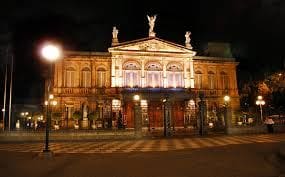
Lifestyle Feature – Crown Jewel of San Jose, National Theater of Costa Rica
As a New Yorker moving to Costa Rica, I experienced some big changes, but nothing more starkly than the lack of theaters and culture in the beach communities. As an opera buff since childhood, I miss going to the Metropolitan or City Opera to see the best performers in the world bring to life the classics with luxurious and extravagant productions and costuming. When I heard Costa Rica was going to host its first opera in many years, I was excited, yet reluctant about what I was going to see. I was not just surprised, but genuinely moved by the professional production, the artistic and imaginative scenery and voices that resonated and brought me to tears. The cast of Costa Rican opera singers were top notch and the experience of seeing it in a 119-year old theater was exhilarating and unforgettable. The National Theater of Costa Rica is a must-visit location when travelling to San Jose.
The theater was built in 1891 during Costa Rica’s coffee boom. The President, Joaquín Rodríguez Zeledón, taxed coffee to create a theater that would house the famous opera singer Adelina Patti, who refused to sing in the small, simple theaters the country had before. Only the best materials were used in the construction, in hopes of creating a national treasure that would reflect Costa Rica’s shift into a more prosperous nation. The first performance, in 1897, was Johann Wolfgang von Goethe’s Faust, and it showcased the finest performers the country had to offer. The building is still considered the foremost historic building in the capital, with a lavish interior and flawless acoustics.
Today, the theater offers both international and national performances, ranging from ballet and dance, philharmonic orchestra, opera and classical and modern theater. In the last year the theater offered La Boheme and an exciting ballet and modern dance interpretation of Alice in Wonderland. It is also common to catch the national philharmonic performing classical and modern compositions. There are midday showings, but the truest experience is to go in the evening, having an excuse to dress to the hilt, sip champagne during the intermission and chat with locals. The theater prides itself on making classical culture accessible to all Costa Ricans with prices that range from four dollars for the third tier to 60 dollars for box seats. Unlike the Met in New York City, where the upper tiers require binoculars, the National Theater does not have a bad seat.
The theater has more to offer than just performances; you can visit the café every day of the week starting at 9 am and enjoy exquisite Costa Rican coffee and delicious pastries, sandwiches and quiches. Sipping coffee in this lush interior is an unforgettable experience. While there you can peruse the statue garden, including Beethoven, Chopin and Calderon de la Barca. Inside the theater you can view the collection of paintings and the impressive mural Allegory of Coffee and Bananas. The architecture is also thrilling, with a neo-classical foyer transporting you right back to the beauty of 19th century design. The opulence is only shadowed by the intense attention to detail. There is nothing like it in all of Costa Rica, which is why it is still considered a crown jewel of San Jose.
The next time you go to San Jose for any reason, and you are assaulted by the brash and utilitarian architecture, which is invariably an effect of the country’s intense seismic activity, travel back to Costa Rica’s golden years by visiting the National Theater. The theater is located on the Avenida Central in downtown San Jose. It offers from two to four performances per month with a variety of options, commonly with at least one performance geared to children.
July 2017 offers two performances. MimoNólogo is an interactive show that mixes mime, clowning and comedy. The performance promises to make the spectator one of the protagonists of the show. The other show in July is El Poeta y la Mariposa (The Poet and the Butterfly), based on a play by the famous and enigmatic Spanish poet Federico García Lorca. Both performances are geared toward bringing children into the fold of culture, while thrilling adults with creative staging and costuming.
For more information, visit the theater website at www.teatronacional.go.cr. It is easy to use, and allows you to choose your seating prior to the show and pick up your tickets at the box office on the night of the performance.
The theater celebrates its 120th anniversary in October, so keep an eye out for what is to come.



